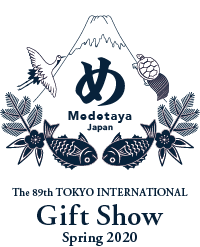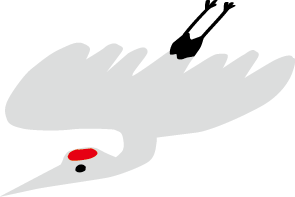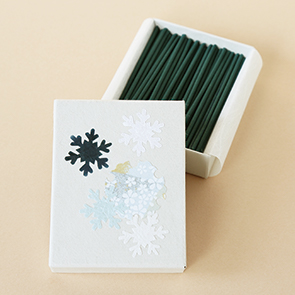


Manekineko refers to a beckoning cat and started being displayed at the entrance of shops in the Edo Period. It is believed to bring in customers with the left paw raised and to bring good luck and fortune to the owner beckoning with the right paw. There is the custom of displaying a lucky cat at stores for successful business.
Daruma doll is believed to have been created based on the myth that Bodhidharma, the founder of Chinese Zen sect, spent nine years in deep Zen meditation gazing at a wall. It relates to the phrase that "fortune will come round."
Otafuku is a mask used as to play a comical middle-aged woman in Satokagura performance. Women with a round, happy-looking face have been believed to ward off disasters since ancient times. Otafuku brings you happiness with mirth.
A Japanese papier mache dog. Dogs are prolific and have easy labor, and puppies grow well. They are also said to have the effect of charming evil spirits. Based on the facts and belief, the dog hariko is regarded as a charm for smooth childbirth and children's growth.
The Chinese lion is thought to have been a holy animal that wards off ogres. When introduced into Japan, it became popular with people as the lion dance for the celebration of the beginning of the year and departure to ward off evil spirits and pray for an abundant harvest.
The seven gods, who have been worshiped since the Muromachi Period, are believed to call forth good fortune. They are: Ebisu (the God of fishing and commerce), Daikokuten (the God of harvest and kitchen), Bishamonten (the God of treasures and wealth), Hotei (the God of contentment and happiness), Fukurokuju (the God of happiness), Jurojin (the God of happiness), and Benzaiten (the God of knowledge). Ebisu is the only one of the seven to originate from Japan.
A mallet brings good fortune when it is shaken, and it belongs to Daikokuten known as the God of harvest and fortune.
Recognized as a world cultural heritage, Mount Fuji garners attention around the world. It has been worshiped as a sacred mountain since ancient times, and climbing for religious belief was active in the Muromachi Period. The magnificent view of the mountain has been frequently sung in verse and drawn .
Sumo can be traced back to an ancient Shinto ritual and has been transformed into a modern national martial art with a unique style. At shrines, sumo bouts sometimes take place as part of an event to pray for world peace and rich harvest as well as purge evil spirits.
Kokeshi are carved wooden dolls that were originally created as a toy for children in the Tohoku area. The dolls with a soft, gentle face can also be a gift to pray for children's healthy growth.

White crane in winter scenery has long captured people's heart and been regarded as an auspicious bird that delivers happiness. Cranes are also a symbol of family's happiness and deep love for their babies.
Along with cranes, turtles have been considered an auspicious animal and a symbol of longevity. In China, they are one of the four most sacred animals and spirits. Even in Japan, sea turtles have been respected as the messenger of the god of the sea.
Sea bream has been an auspicious symbol for its red, rounded, graceful form and on the fact that Ebisu, one of the seven gods of good fortune, holds it. Also, it is because the Japanese word for sea bream, tai, sounds similar to the word "medetai" or "felicity."
Shrimp have been considered auspicious for their long antennae and curved body like the curved back of the elderly. They are essential to the festive table and prayer for the New Year's Day.
Pigeons often symbolize peace. In Japan, they are also considered the messenger of Hachimanshin known as the God of war and used as a charm for battles.
Chidori pattern depicts a flock of birds flying over the riverside or beach. With a pun for the name of chidori, it can be used for praying to win.
Shochikubai, each of which has a meaning of a plant describing an auspicious occasion: pine (sho), bamboo (chiku), and ume plum (bai) respectively. Long-lived pine symbolizes longevity, bamboo that grows straight represents healthy growth, and ume plum that bears flowers in early spring denotes nobility.
In Japan, the dark markings on the side of the moon is interpreted as a rabbit making rice cake. Rabbits, known as a symbol of family prosperity, are said to gather luck with their long ears.
Known as lion dogs, Komainu are statue pairs of lion-like creatures at both sides of the approach to a shrine. One has the mouth open while the other closed. Giving a glare, they guard a sacred place.
Tigers are believed to chase and rescue their cubs when snatched away however fast an animal is, leading to a symbol of family love.
Tairyo-bata are fisherman's flags that used to be originally flown by boats to signify a large catch of fish. The flags have bright colors, an intricate design and good luck charms painted with dynamic brush strokes including sea bream and treasure ships. Tairyo-bata are emblematic of the strength of fishermen living with nature.
The Oishii series is the collection of tasty food in Japan, colorfully depicted. Fill your heart with a pop of color.
In the motif of Fujisan, it is illustrated with a pop of color. It is a lucky charm that blends in everyday life.
This is the collection of postcards depicting downtown Tokyo that is steeped in tradition, other landmarks, and specialties.
Spring ----- A warm, spring breeze allows wild flowers to come into bloom. Doll's Festival is celebrated on March 3, when hina dolls are displayed, to pray for the healthy growth and happiness of young girls. Japan welcomes the cherry-blossom season in April.
Summer ----- People in Japan crave for visually and audibly cool items to get through the summer heat. Shading the sun with a bamboo blind, they keep themselves cool by eating watermelon and shaved ice. Fireworks light up the night sky at a summer festival.
Autumn ----- People have found beauty in falling flowers and leaves in Japan while relishing short but gorgeous fall foliage. Medetaya offers moon viewing with a rabbit making rice cake on the moon.
Welcoming Spring ----- The beginning of the year is when things are full of new life. Decorations such as Kadomatsu and an offered rice cake are displayed to welcome the Toshigami-sama deity heralding the advent of the New Year. People celebrate the New Year drinking toso sake to aspire for longevity and pray for happiness with good luck charms.
![]()
Woody
Floral
Sweet
Floral
Sweet
Floral
Sweet
Floral
Mint
Marine
Citrus

Floral